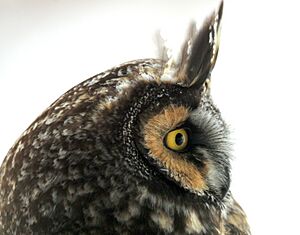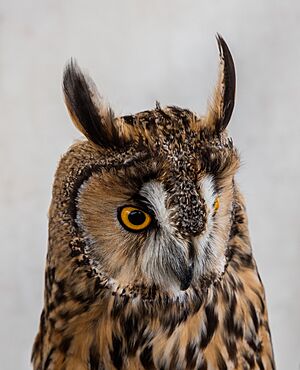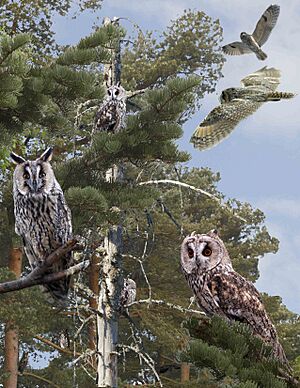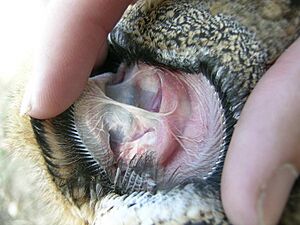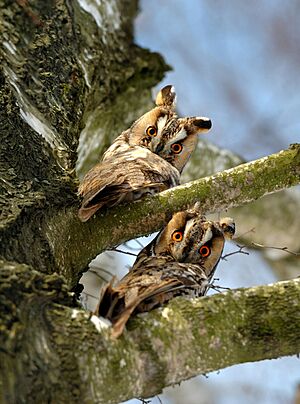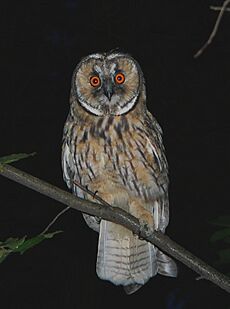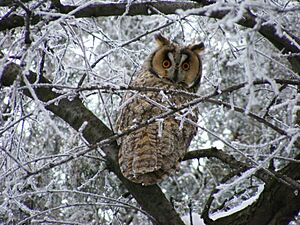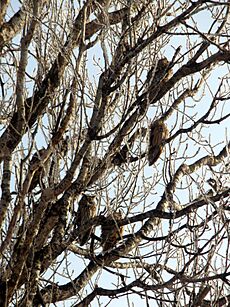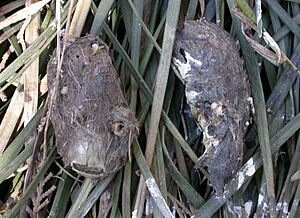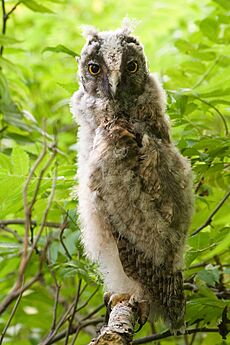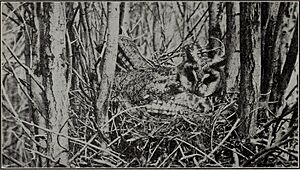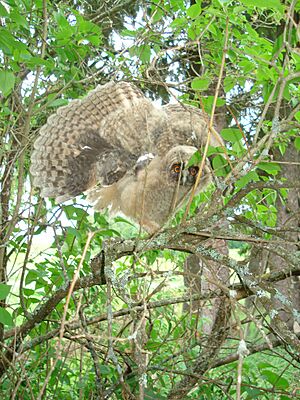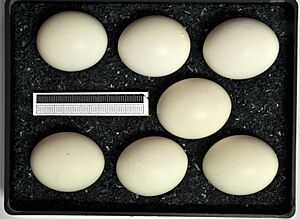Long-eared owl facts for kids
Quick facts for kids Long-eared owl |
|
|---|---|
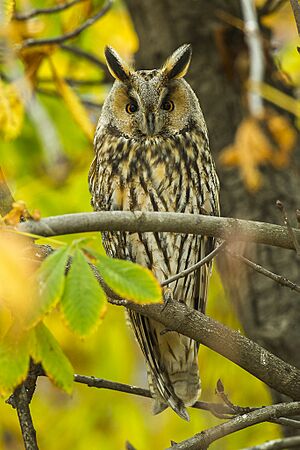 |
|
| A long-eared owl in Hungary | |
| Conservation status | |
| Scientific classification | |
| Genus: |
Asio
|
| Species: |
otus
|
 |
|
| Range of A. otus Breeding Resident Non-breeding Extant (seasonality uncertain) | |
| Synonyms | |
|
|
The long-eared owl (Asio otus) is a medium-sized owl found in many parts of the world. People also call it the northern long-eared owl, or sometimes the lesser horned owl or cat owl. Its scientific name, Asio, means "horned owl" in Latin. The second part, otus, comes from Greek and also refers to an owl with ears.
These owls live in Europe, Asia, and North America. They are part of the typical owl family, called Strigidae. Long-eared owls like places with both thick woods and open fields. They prefer to rest and nest in dense trees. But they hunt for food in open areas.
This owl mostly eats small rodents, especially voles. Voles are often their main food. However, if voles are scarce, or if the owls live in dry or city areas, they can eat other things. This includes birds and insects. Long-eared owls do not build their own nests. They usually use nests built by other birds, like crows.
Unlike many owls, long-eared owls do not always stay in one place. They are partly migratory. This means they move to different areas for winter. They often share roosting spots with many other long-eared owls. This species is one of the most common owls in the world. The IUCN lists it as a least concern species. But in some places, their numbers are going down.
Contents
- Understanding Long-Eared Owls: Taxonomy
- Physical Characteristics: What Do Long-Eared Owls Look Like?
- Where Long-Eared Owls Live: Distribution and Habitat
- Daily Life of Long-Eared Owls: Behavior
- What Long-Eared Owls Eat: Dietary Biology
- Who Hunts the Hunter: Interspecies Predatory Relationships
- Family Life: Reproduction and Life Cycle
- Current Status of Long-Eared Owls
- In Art
Understanding Long-Eared Owls: Taxonomy
The famous Swedish scientist Carl Linnaeus first officially described the long-eared owl in 1758. He gave it the name Strix otus. Later, in 1760, it was moved to the genus Asio by a French zoologist.
Owls in the Asio group are often called "eared owls." There are only eight modern species in this group. Four of these species, including the long-eared owl, live in both Eurasia (Europe and Asia) and the Americas. Even though they are in the same group, studies show that long-eared owls and short-eared owls are quite different genetically.
Some other owl species are related to the long-eared owl. These include the Stygian owl, Madagascar owl (found only on Madagascar), and the Abyssinian owl (from east Africa). These related owls usually live in warmer, wetter places. They have darker feathers and are larger.
Types of Long-Eared Owls: Subspecies
There are four main types, or subspecies, of the long-eared owl:
- A. o. otus: This is the most common type. It lives across Europe and Asia, from the British Isles to Japan. Some of these owls fly south for winter to places like Egypt or India. This type has a pale face with black edges. Its ear-tufts are dark brown with light edges.
- A. o. canariensis: This type lives only on the Canary Islands. It is the smallest subspecies. These owls are darker than the common type. They have brighter reddish-orange eyes.
- A. o. wilsonianus: This type is found in Canada and the southern USA. American long-eared owls often have brighter markings. Their faces are rufous (reddish-brown) with strong black edges. Their eyes are usually deep yellow.
- A. o. tuftsi: This type lives in western Canada and the south-central USA. It has paler feathers than A. o. wilsonianus. Its brown markings are lighter and less widespread.
Physical Characteristics: What Do Long-Eared Owls Look Like?
The long-eared owl is a slim owl with long wings. It has noticeable ear tufts on its head. These tufts are closer to the middle of the head than on other owls. Scientists believe these ear tufts help owls communicate with each other. They might show how the owl is feeling or what it intends to do.
Long-eared owls are usually a mix of ochre (yellowish-brown) and tawny (orange-brown), with some gray or brown mixed in. They have blackish streaks on their wings and back. Their shoulder feathers are often whitish, which stands out. The underside of the owl is usually paler. It has dark streaks on its upper chest.
The owl's face has a clear "facial disc" that helps direct sound to its ears. This disc can be different colors depending on the subspecies. It often has a dark rim and white lines around the beak. The ear tufts are dark in front and lighter behind. Long-eared owls have black beaks and eyes that can be yellowish-orange to orange-red. Their legs and toes are covered in feathers.
This owl is a medium-sized bird, about 31 to 40 centimeters (12 to 16 inches) long. Its wingspan is large for its size, reaching 86 to 102 centimeters (34 to 40 inches). However, long-eared owls are lighter and more slender than other medium-sized owls like the barn owl or tawny owl.
Female long-eared owls are usually a bit larger than males. This is common in owls and other birds of prey. Males also tend to have paler feathers. In Finland, male owls weighed about 288 grams (10 ounces), while females weighed about 327 grams (11.5 ounces). Overall, males can weigh from 160 to 330 grams (5.6 to 11.6 ounces), and females from 180 to 435 grams (6.3 to 15.3 ounces).
How to Identify Long-Eared Owls
Experienced birdwatchers can usually spot a long-eared owl by its look, size, and colors. But some other owls can look similar. The Stygian owl is larger and darker. Tawny owls are rounder and heavier. They also don't have ear-tufts and have dark brown eyes. The Eurasian eagle-owl is much bigger with huge feet and ear-tufts on the sides of its head.
In North America, great horned owls are also much larger. They have a square-shaped head and ear-tufts that are far apart. Scops owls and screech owls are much smaller and have different markings.
Long-eared owls often live in the same areas as short-eared owls. Short-eared owls are slightly larger. It can be tricky to tell them apart, but they prefer different habitats. Short-eared owls like wide-open, treeless areas like wetlands or prairies. Long-eared owls prefer the edges of woods.
When resting, the long ear-tufts of the long-eared owl help tell them apart. Short-eared owls have yellow eyes, while long-eared owls often have orange eyes. Short-eared owls are also paler and sandier in color. In flight, short-eared owls have a wide white band on the back of their wings, which long-eared owls do not.
Sounds and Hearing: Vocalizations and Ear Morphology
Long-eared owls have very large ear openings on the sides of their heads. These ears are placed unevenly, with one higher than the other. This helps them hear sounds from both above and below. Their hearing is about ten times better than humans at hearing high and medium sounds. This amazing hearing allows them to hunt in the dark. They can also use their hearing to find other owls and avoid predators.
Long-eared owls make many different sounds. Scientists have recorded 23 different calls from them. The male's song is a deep "whoop" sound, repeated every few seconds. It can be heard up to 1 to 2 kilometers (0.6 to 1.2 miles) away on a quiet night. Female owls make a weaker, higher-pitched, nasal sound. Females usually call when they are with a male during courtship or near the nest.
Both male and female owls make cat-like "jaiow" notes or high "yip-yip" sounds. When disturbed near their young, parents may make a series of "watt-watt-watt-watt" sounds. During courtship, the male owl claps its wings together while flying. Like many owls, they will hiss and snap their beaks if they feel threatened, especially near their nest. Young owls make high-pitched, drawn-out calls that sound like a rusty gate.
Where Long-Eared Owls Live: Distribution and Habitat
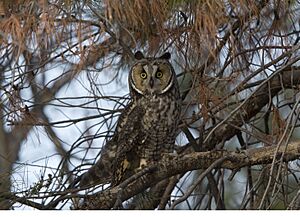
Long-eared owls live across a huge area. In Europe, they are found from the British Isles all the way east through Russia. They live in most of Europe, though they are less common in some parts of Italy and Southeastern Europe. In Scandinavia, they breed in the southern two-thirds of Norway, Sweden, and Finland. They can be found as far north as the Subarctic zone in Norway. They also live in the Azores, Canary Islands, and parts of north Africa.
In Asia, they are widespread in Russia, Kazakhstan, and Mongolia. They also live in parts of China and Japan. Some populations move south for winter to places like Pakistan, northern India, and southern China.
In North America, they are found in much of Canada and the United States. They breed in British Columbia, Alberta, Manitoba, Ontario, and Quebec. Many Canadian owls move south for winter. In the U.S., they breed more widely in the west, from Washington to California and Arizona. They also breed in the Midwest. During winter, they can be found across much of the U.S. and into Mexico.
Preferred Homes: Habitat
Long-eared owls like open areas with short plants for hunting. They also need wooded areas for resting and nesting. They can live at many different elevations, but usually not above the tree line in mountains. They have been seen nesting as high as 2,700 meters (8,858 feet) above sea level in Kashmir.
These owls often live in landscapes with groups of trees, hedges, or small woods. They can also be found in pastureland with trees, forest edges, and even parks or cemeteries with trees. Surprisingly, they can adapt to desert and semi-desert areas. In these places, they might nest in oases and hunt over the open desert ground.
In many studies, long-eared owls prefer conifer (evergreen) trees for nesting and roosting. They often choose dense stands of conifers. They like to be near cultivated land or open fields for hunting. They are adaptable to both very cold and quite warm areas. However, they mostly stay in temperate zones of the north. They are less adaptable to different climates than the short-eared owl, which can live in the Arctic and tropics.
Daily Life of Long-Eared Owls: Behavior
Long-eared owls are mostly active at night. Their activity usually starts at dusk. They are most active between 10 PM and midnight, and again from 3 AM to 5 AM. If they live very far north, where the summer nights are short, they might have to hunt during the day. When they fly during the day, other birds like crows often bother them.
Unlike most owls, long-eared owls do not have a fixed hunting territory. They will hunt over a wide area. Studies have shown they use large areas, especially fields near woodlands. They avoid completely treeless places. Owls living in cities might have larger hunting areas to find parks and avoid busy human activity.
Traveling South: Migration
The long-eared owl is one of the few owl species that truly migrates. Northern populations fly south in autumn. Some young birds from central Europe might travel over 2,000 kilometers (1,240 miles). Adult owls in central Europe usually don't migrate as far. Owls that breed in Scandinavia might fly to almost anywhere in Europe for winter.
In Europe, male and female owls seem to migrate differently. More females are found in wintering areas in Denmark and southern Sweden. This might be because females avoid areas with many large predators. Or they might avoid deep snow, which makes it hard to catch prey.
In North America, owls from Canada and the northern U.S. often winter across the rest of the United States and even parts of Mexico. Long-eared owls can also have "irruptive" movements. This means their populations can suddenly increase and spread out in many directions when there's a lot of prey. They might appear in large numbers in new areas, especially if a year with lots of prey is followed by a winter where prey numbers crash.
Social Life: Roosting Behavior
During the day, long-eared owls usually rest upright on a tree branch, often close to the trunk in dense leaves. In winter, they often stay in the same group of trees. If you get close, the owl will freeze. It stands stiffly, closes its eyes to narrow slits, and raises its ear tufts. This is called the "tall-thin position." If you get too close, it will fly away to another spot.
Unlike most owls, long-eared owls often gather in groups to roost during the non-breeding season. These groups can have 6 to 50 owls, and sometimes even up to 150 owls in one spot in Europe! They tend to roost in the darkest parts of tree stands to hide. But they like to be close to the edge of the forest so they can easily fly out to hunt in open areas.
Studies show that owls often return to the same trees or groups of trees for roosting each year. They prefer conifers like cedars where the main trunk is hidden. They usually roost between 3 to 15 meters (10 to 50 feet) high. Owls generally leave their roosts for hunting about 40 to 49 minutes after sunset. Roosting in groups might help them stay safe from predators.
What Long-Eared Owls Eat: Dietary Biology
Long-eared owls often hunt in two shifts: one before midnight and one after, ending an hour before sunrise. They hunt mostly along the edges of woods, hedgerows, and open grasslands. They fly low and slowly, often only about 1.5 meters (5 feet) above the ground. They usually find their prey by sound, listening for rustling in the grass.
Studies show that long-eared owls are very good at finding mice by sound in complete darkness. They are even better than some other owls, like tawny owls. Once they hear prey, they stop flying and quickly drop down with their talons (claws) spread to catch it. Even if there are many voles in the woods, long-eared owls will often go to open fields to hunt. This is because it's easier to hear and catch prey in open areas.
The long-eared owl's foot span is about 11.3 to 12.5 centimeters (4.4 to 4.9 inches), including its claws. This is quite small for an owl of its size. Their talons are sharp, but their feet are relatively weak. However, they are still very good at catching small prey.
Overall, the long-eared owl's diet can vary a lot around the world. Scientists have looked at over 800,000 prey items from many studies. They found 478 different prey species. But, the long-eared owl is actually a very specialized hunter. It mostly eats small mammals, especially rodents. In Europe, mammals make up 80% to 99% of their diet.
The average size of prey for long-eared owls is usually small. In Europe, the average prey size is about 32.2 grams (1.1 ounces). In North America, it's between 30.7 and 37 grams (1.1 and 1.3 ounces). Generally, their prey weighs between 20 and 50 grams (0.7 to 1.8 ounces). Only rarely do they catch prey weighing 60 to 100 grams (2.1 to 3.5 ounces) or more.
Mammals: Their Main Food
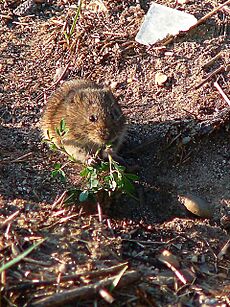
Long-eared owls get almost all their energy from rodents. They are especially linked to voles. Voles are small-to-medium-sized rodents with short tails. In Europe, the long-eared owl is a specialist vole hunter. In many studies, voles make up more than half of their diet. In central Europe, the common vole (Microtus arvalis) alone makes up about 76% of their food.
Vole populations go up and down in cycles. When there are many voles, long-eared owls lay more eggs and raise more young. When voles are scarce, they lay fewer eggs or might not breed at all. In low vole years, they might eat more mice, but this doesn't help them breed as well.
In some parts of Europe, like large islands or Scandinavia, common voles are rare. In these places, long-eared owls eat other rodents. This includes field mice (Apodemus) or house mice (Mus). In Sweden, field voles are the main food. In Ireland, where there are no native voles, wood mice are their primary food.
In warmer areas like Italy or the Canary Islands, their diet can change. In Italy, they might eat Savi's pine voles or wood mice. In the Canary Islands, the introduced house mouse is their main food. Sometimes, if they live near landfills, they might even catch large brown rats.
In North America, long-eared owls also eat mostly small rodents. But their diet is a bit more varied than in Europe. The further north they live, the more they rely on voles. The meadow vole (Microtus pennsylvanicus) is a common food in places like Michigan and Wisconsin. In other areas, especially drier ones, they eat pocket mice and kangaroo rats. These are common in the American southwest.
Other mammals are rarely a big part of their diet. They sometimes eat shrews, but not as often as barn owls do. They also occasionally catch bats. In Beijing, China, bats made up a surprising 28.6% of their diet, especially in city areas. Very rarely, they might catch small rabbits or hares. The largest mammal ever recorded for a long-eared owl was an 800-gram (1.7-pound) black-tailed jackrabbit. They have also been seen eating dead animals like crested porcupines or European pine martens, but they certainly didn't kill these large animals themselves.
Birds: Occasional Meals
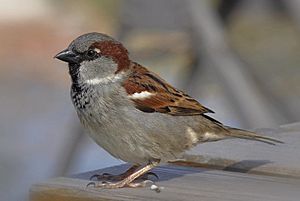
Long-eared owls don't usually hunt many birds. But in winter, especially when there's snow, they might switch to eating small birds. They sometimes hover around bushes to scare sleeping birds out, then catch them. They have also been seen hunting night-migrating passerines (songbirds) near lights.
In cities or dry areas, they often eat house sparrows and Eurasian tree sparrows. In Jerusalem, birds made up over 90% of their winter diet, mostly house sparrows and blackcaps. In Europe, birds usually make up about 8% of their diet. But in years with few voles, birds can make up as much as 33% of their food.
Many studies in Italy show that long-eared owls eat a lot of birds, especially in winter. In the Venice area, birds made up 38.47% of their diet by number. In Romania, birds were the main food for wintering owls in the Danube delta, making up 59.5% of their prey.
While most birds they catch are small, long-eared owls sometimes attack surprisingly large birds. They have been known to catch birds weighing around 100 grams (3.5 ounces) or more, like larger thrushes or jays. In Europe, they have even caught birds like common wood pigeons (490 grams or 1.1 pounds) and red-legged partridges (528 grams or 1.16 pounds). In North America, they have caught Northwestern crows (392 grams or 13.8 ounces) and even large ruffed grouse (over 600 grams or 1.3 pounds). One record even mentions a sharp-tailed grouse weighing 885 grams (1.95 pounds), which is three times heavier than the owl itself!
Other Prey: Rarely Eaten
Besides mammals and birds, long-eared owls rarely eat other types of prey. Sometimes they catch reptiles like snakes and lizards, or amphibians like frogs and toads. This happens more often in warmer, drier places like the Canary islands or the American southwest. Fish are almost never eaten.
Insects are usually a very small part of their diet, less than 2% in Europe. But in some studies, insects can make up a larger portion. For example, in central Poland, one type of beetle made up 25% of their prey. In the Canary islands, insects were recorded as 33% of their food, including bush crickets and field crickets.
Who Hunts the Hunter: Interspecies Predatory Relationships
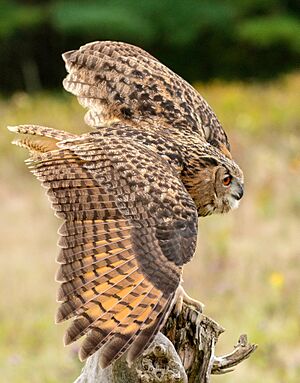
Long-eared owls share their habitats with many other birds of prey. Many owls hunt rodents, so there can be competition for food. However, long-eared owls often avoid direct competition by choosing specific habitats or hunting at different times.
In Europe, the tawny owl is very common. Tawny owls also eat rodents but are more flexible, eating more birds, reptiles, and insects. Tawny owls prefer denser woods, while long-eared owls like forest edges. Even though tawny owls are larger, their presence doesn't seem to harm long-eared owl breeding.
Long-eared owls are largely safe from competition with short-eared owls because short-eared owls prefer completely open habitats. They nest in tall grasses, not trees. Barn owls also hunt in open areas and eat small mammals. But barn owls are more adaptable and can live on many different types of prey, even without small mammals. Barn owls also nest in cavities, unlike long-eared owls.
In North America, there are more owl species, so competition might be higher. However, different habitat choices and slight differences in diet usually allow species to coexist. Long-eared owls are more migratory than most other North American owls. This means they are less likely to die from food shortages in winter.
Predators of Long-Eared Owls
Long-eared owls are often victims of other predators. Their habit of nesting in open bird nests, their loud calls, and their hunting in open areas can attract predators.
In Europe, their main predators are the Eurasian eagle-owl and the northern goshawk. Eagle-owls often kill long-eared owls. Some scientists believe that long-eared owls avoid areas with many eagle-owls. Many other diurnal birds of prey (birds active during the day) also hunt long-eared owls. These include golden eagles, Bonelli's eagles, and various types of buzzards and falcons. Goshawks are especially dangerous because they actively search for owls in thickets. Tawny owls and Ural owls also sometimes kill long-eared owls.
In North America, the great horned owl is the most dangerous predator. Barred owls also hunt long-eared owls. Other predators include golden eagles, northern goshawks, and red-tailed hawks.
Mammals can also be predators, especially near nests. European pine martens and stone martens might eat eggs and nestlings. In North America, raccoons are a threat. They can even kill adult female owls on the nest. Corvids like magpies and crows, which build the nests long-eared owls use, will sometimes raid the nests and eat eggs or young.
On the other hand, long-eared owls themselves sometimes hunt smaller owls. They have been known to prey on eastern screech owls, little owls, and Eurasian pygmy owls.
Family Life: Reproduction and Life Cycle
Long-eared owls usually have one mate for life. If they don't migrate, they often stay together year-round. Males claim their territory by singing and clapping their wings. They sing mostly at dusk on quiet nights. The male usually sings from a tree branch.
Long-eared owls can nest quite close to each other, sometimes only 50 to 150 meters (164 to 492 feet) apart. If there's plenty of food, many pairs might nest in the same area. The female chooses the nest site and sings to the male. Breeding happens later in the year than for some other owls, usually in March or April. Rarely, they might breed as early as February.
Long-eared owls almost always use old stick nests built by other large birds. These include nests of crows, magpies, or hawks. In Europe, most nests are built by carrion or hooded crows and Eurasian magpies. They often choose nests in conifer (evergreen) trees. Nest height and size are important for nest selection.
Sometimes, long-eared owls will even chase away the previous bird living in a nest. This shows how determined they can be! Very rarely, they might nest in shallow holes in trees or cliffs. They are not usually cavity nesters. Some nests have even been found on the ground, among plants. People have also put out wicker baskets in trees for them, which the owls sometimes use.
Egg-laying usually happens between late March and early May. Females typically lay 3 to 5 eggs. If there's a lot of food, they might lay more. In years with many voles, they have been known to lay up to 8 eggs in Sweden, and even 10-11 eggs in Russia! The eggs are pure white and weigh about 23 grams (0.8 ounces). They are laid every 1-5 days.
The female owl alone sits on the eggs, which takes about 27-28 days. The male brings her food. She might leave the nest briefly to eat early in the incubation period.
The young owls hatch between late April and June, about two days apart. Their eyes open at 5-7 days old. The mother broods (sits on) them for about two weeks. The male continues to bring food to the nest. Parents will defend their nest, especially as the young get older. They might ruffle their feathers, spread their wings, hiss, and snap their beaks to look bigger and scarier. If a threat gets too close, they might even try to scratch with their talons.
The young owls leave the nest at 20-27 days old. At first, they can't fly well and just climb around on nearby branches. They are called "branchers." If they fall to the ground, they can usually climb back up. At dusk, the branchers call loudly to their parents to be fed. They can fly well at about 35-37 days old. But they often stay with their parents and are fed by them for up to two months.
In North America, they usually have one group of young per year. But in years with lots of voles, they might have two. One pair in Idaho successfully raised 11 young in two broods because there was so much food.
Nesting success depends on many things. Raccoon predation is a common reason for nests to fail in Idaho. In Britain, human egg theft was a common cause of failure. Overall, reproduction is more successful when there are more prey animals. In Germany, if there were few voles, no breeding pairs were found. But a year later, with many voles, 19 pairs nested in the same area.
Long-eared owls usually have short lifespans. Most owls found in studies were 4 years old or younger. The oldest recorded in North America was 11 years and 4 months old. One exceptional owl in Europe lived to be almost 28 years old.
Current Status of Long-Eared Owls
The long-eared owl is quite common and widespread. It lives across 80 million square kilometers (30 million square miles), making it one of the most widely found owls. The IUCN estimates there are between 2 million and 5.5 million long-eared owls in total. This makes them one of the most numerous owls in the world.
Long-eared owls are less common in very hot, dry climates where insects and reptiles are more common than small rodents. They are also scarce in very dense forests or treeless northern areas like tundra, where short-eared owls might live instead. The number of owls in an area depends on how much food is available.
Local threats to long-eared owls include pesticides and people harming them. In the past, some people would shoot owls because they didn't understand their role in nature. Even though it was known that long-eared owls help humans by eating pests, some hunters still shot them. This persecution caused their numbers to drop in North America in the early 20th century.
Long-eared owls can also be harmed by chemicals like mercury and rodenticides (rat poison). These chemicals can build up in their prey. They can also get sick from parasites or diseases like West Nile virus. Many owls are also killed by cars on roads.
In some areas, people are trying to help long-eared owls. In Switzerland, wintering owls in towns were fed white lab mice to help them survive. Building artificial nesting platforms can also encourage them to breed.
However, long-eared owls are still facing challenges. In southern California, they have lost over 55% of their habitat due to human development. In New Jersey, many known roosting sites have been destroyed. Changes in land use and habitat destruction reduce the quality of their homes and the number of voles available.
Studies in Canada show that long-eared owl populations have declined significantly. They are among the owl species with the most severe declines in North America.
In Art
The famous artist John James Audubon painted the "Long-eared Owl - Strix otus" as Plate 383 in his book Birds of America, published in the 1800s.



